

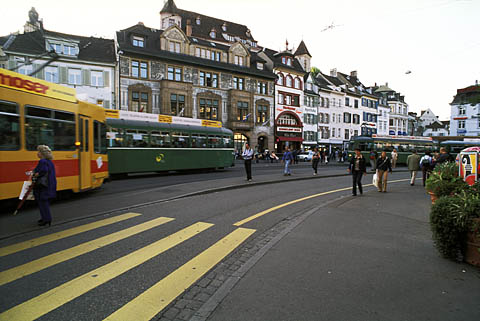
Major tram halt, Basel, Switzerland


2002 J.Crawford
In the last article, we examined the need for better cycling and walking. Here we turn to the question of where to begin carfree conversions and how to increase density in the carfree areas. The strategy is simple and obvious: start at the transport halts and gradually expand the carfree areas as alternatives to cars and trucks become readily available.
The matter of increasing the density of the building stock is more complex and specific to a particular city, but the methods are simple and well known. Narrowing streets and reclaiming the space for buildings is not too difficult, although it is almost never done. If the city owns the land, its sale becomes a major source of money.
Start at Transport Halts
In all likelihood, most conversions of existing cities will be based on trams (light rail, etc.) running in the streets, if only because the cost of building underground metros in existing urban areas is extremely high. As pointed out in an earlier article, large-scale conversions will have to begin with the establishment of a route network for new public transport service. (In a few cities, existing service will suffice, but even in Manhattan, some additional service would be necessary.)

Major street with tram service, Strasbourg


1997 J.Crawford
This leads to the construction of new tram lines across the city. Unless the conversion can wait until the new tram lines are built and operating, it will be necessary to start operating the routes with buses. Since the routes are most likely to follow existing major streets, we will find it necessary to remove all car traffic from those streets. Buses will run near the curbs, leaving the middle of the street free for tram-line construction. Keeping cars entirely out of these streets will permit the buses to run without interference from car traffic, which is essential to on-time performance for any surface-running public transport.
Given that these streets will have to be made carfree at the start, and given that the areas near the transport halts will be the most valuable, the first conversions should be in the few blocks adjacent to each halt. These are the locations where density will be increased, so that the maximum number of people can live and work as close to a transport halt as possible. By establishing large populations close to each transport halt, it becomes possible to run frequent service that is heavily used and has a relatively low per-passenger operating cost.
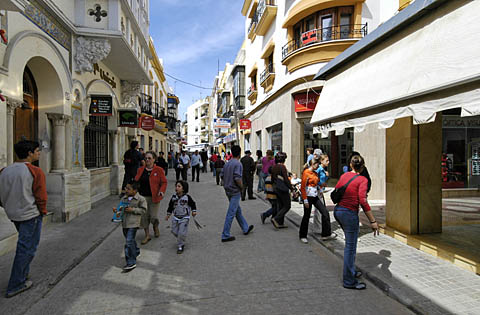
Narrow pedestrian street, Ayamonte, Spain


2005 J.Crawford
The remaining streets will initially remain open to at least some level of motor vehicle traffic. This will permit freight deliveries to be made by truck to streets near the carfree areas. Handcarts can be used to deliver goods the last hundred or so meters. It would also be possible to permit some residents of the area to park a car on these streets. However, a shortage of parking will arise when the tram-route streets are closed to cars, and people who do not live in the neighborhood may no longer be permitted to park in it, or possibly even to enter it.
Part of the master plan will involve the provision of an interchange area, preferably at the edge of the city, where drivers from rural areas can park their cars and switch to public transport. These facilities would ideally be built early in the process, so that they are in operation by the time the trams begin to run.
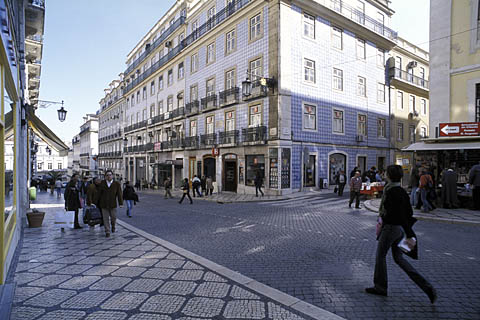
Pedestrian street, Lisbon


2003 J.Crawford
How far out from each halt should the initial carfree area extend? This is a difficult issue, because access by vehicles cannot yet be entirely eliminated until the new infrastructure is complete and until the permanent freight delivery system is in operation. This suggests that the walking distance from the transport halt to the edge of the carfree district might not exceed three minutes in the first phase. This translates to a little more than 200 meters, not as the crow flies but as the pedestrian walks. This is an important point, because it is unlikely that the existing street pattern will be a radial arrangement centered on the transport halt. Most cities are built on grids, which are not ideal for carfree arrangements. Every effort should be made to establish pedestrian shortcuts across blocks so as to shorten trips on foot.
As mentioned earlier in this series, discouraging car traffic can be done in many different ways. This effort should begin as early as possible and should be pursued vigorously. As long as it is possible to do something without using a car, using the car should be made slow, difficult, and expensive. This requires a major change in attitude, because it stands the current car-centered paradigm on its head.
Some cities are arranged in a particularly useful manner for our purposes. These are places, such as New Orleans, that have "superblocks." These are merely large blocks, delineated by wide streets, that contain small blocks delineated by narrower streets. Public transport can be established along the major streets, and the quiet back streets can gradually be converted to carfree areas.
Increase Density and Reduce Street Width
Most cities will require increased population densities near transport halts in order to support the high quality of public transport that is required. There are a few notable exceptions, such as Manhattan and Hong Kong, where density actually exceeds by a considerable margin the density required to support good public transport. Elsewhere, buildings will have to be built taller (up to a few stories) and streets will have to be made narrower. These two actions can sufficiently increase density while also freeing up some land for green space out at the edges.
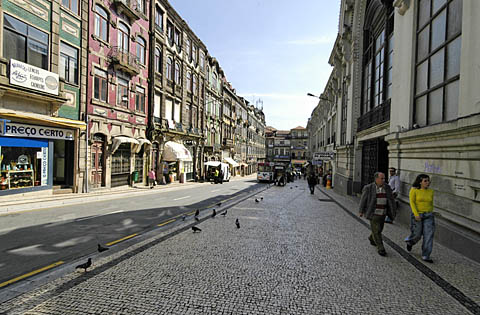
Mixed-use area, Porto


2005 J.Crawford
Essential to any well-functioning carfree area is the mixing of uses. Residences, shops, services, schools, and workplaces must all be located in every neighborhood. This minimizes the amount of time spent traveling: we provide access by proximity, not by mobility. This is the most difficult point for existing North American suburbs. Zoning prohibited mixed uses, with the result that most trips are beyond walking distance. Make sure that essential goods and services are within walking distance.

Busy commercial street, Fes-al-Jdid, Morocco


2002 J.Crawford
In most jurisdictions, this change will require changes in local regulations. Buildings above two stories are not permitted in many places. Buildings are often required to be separated from their neighbors by certain minimum distances, and setback from streets is usually required. Parking and access requirements for cars preclude the necessary changes. No progress can be made without a change in regulation. The support of the local government is thus essential.
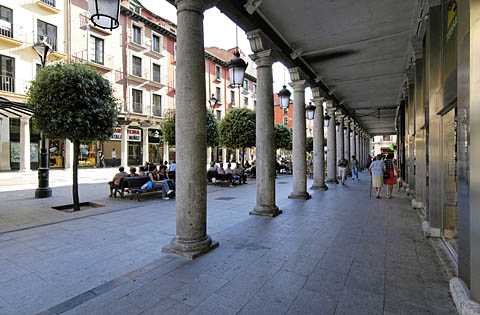
Arcade, Valladolid, Spain


2005 J.Crawford
In areas that already have a somewhat urban quality, with buildings that abut one another other, the effective width of the street can be reduced by allowing buildings to extend into the area above the existing sidewalk, thereby creating arcades. The arcade is a wonderful device in carfree cities, as it provides good protection from rain. It also makes a nice transition between the openness of the street and the confinement of the buildings.
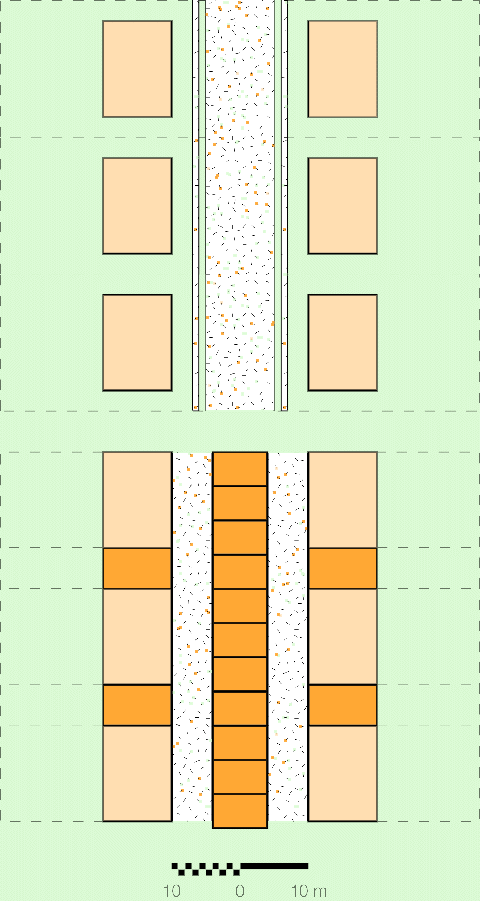
Infill development


2000 J.Crawford
In some cities, streets are so wide that rows of new buildings can be constructed down the middle of the street, creating two rather narrow streets in place of one broad street intended for cars. It is difficult to grasp this concept because we have become so accustomed to the 6, 8, and even 10 lane streets that dominate life in cities of the automobile age.

Wide street for cars, Lisbon


1999 J.Crawford
The process is not as simple as it might first appear, as utilities are buried beneath the street. Moving utilities so that buildings can be constructed in the middle of the street is a messy, complex, expensive, and time-consuming process. At best, this will be achieved over a span of decades. In the mean time, we can create the narrow, comfortable streets we seek by placing one- or two-story buildings in the street. These can be semi-permanent structures that are easy to move. They are light enough that they need only be tied down against wind and earthquake. The street itself can serve as the foundation.
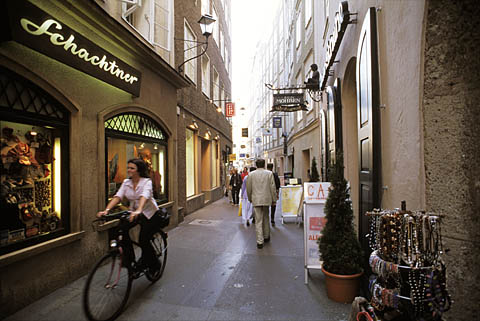
Narrow street for people, Salzburg, Austria


2002 J.Crawford
One intriguing possibility is to construct lightweight metal buildings using the excess capacity of the automotive industry. This would retain jobs in this hard-hit sector while providing useful employment. I regret to say that I have never quite worked out the details of how this might be accomplished. If it is not feasible, the manufactured-housing industry ought to be able to supply the buildings we need using well-established techniques. I don't see any intrinsic reason that these buildings must be as ugly as they usually are.
In the next and final installment in this series, we will consider the creation of new public squares and the provision of additional green space adjacent to densely-populated urban areas.
First published in CarBusters #41 (March-May 2010).
|